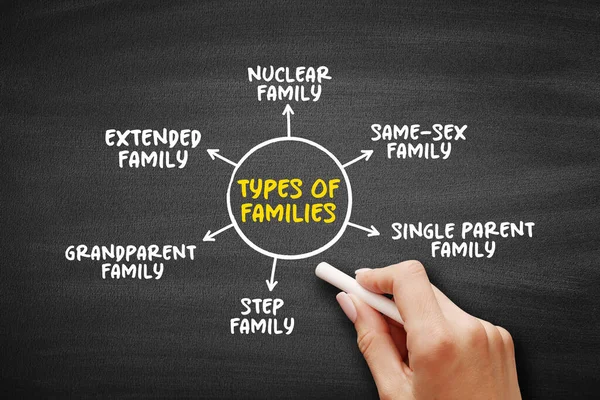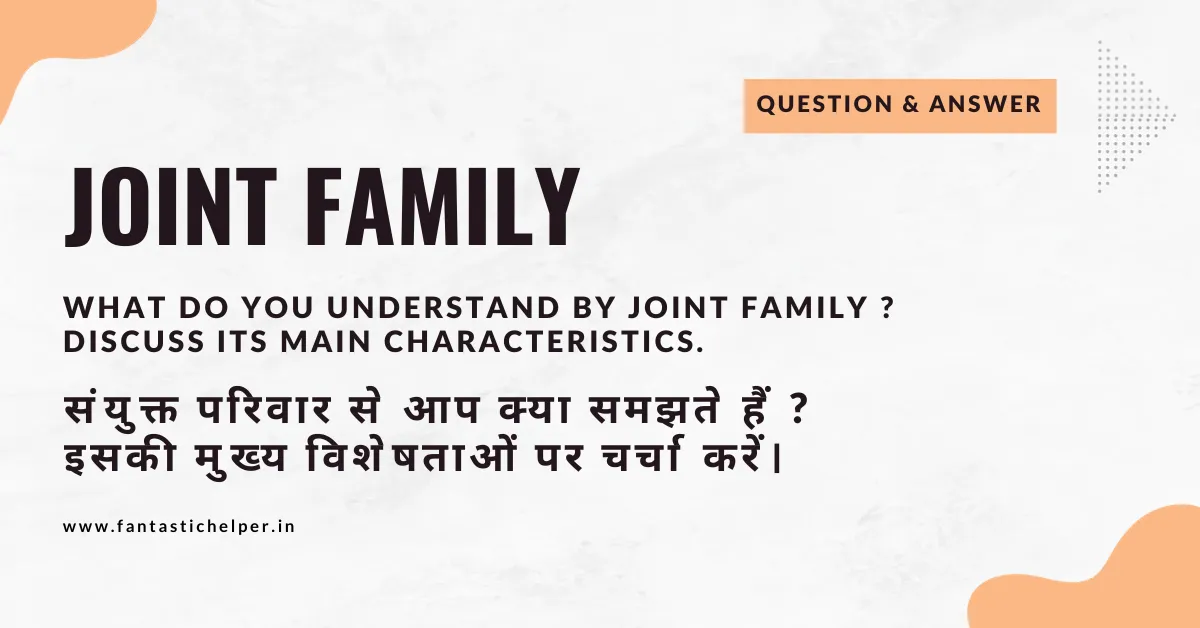What do you understand by joint family ? Discuss its main characteristics.

Meaning & Definations:
A joint family is a type of extended family structure where members of multiple generations, such as grandparents, parents, uncles, aunts, and their children, live together as a single household. This arrangement fosters close familial ties and encourages a sense of unity among family members. Joint families are characterized by shared responsibilities, resources, and decision-making. The head of the family, typically the eldest member, plays a central role in managing family affairs and maintaining harmony.
In a joint family, individuals often collaborate in various aspects of daily life, including financial matters, child-rearing, and domestic chores. The joint family system has been a traditional and prevalent social structure in many cultures, particularly in countries like India. However, societal changes, urbanization, and evolving lifestyles have led to a shift toward nuclear families in some regions.
The joint family model emphasizes mutual support, interdependence, and collective well-being, contributing to a sense of belonging and emotional security among its members. While it has its advantages, such as shared responsibilities and a built-in support system, it may also pose challenges related to personal space, autonomy, and conflicts arising from diverse opinions within the extended family.
The main characteristics of a joint family include:
- Multiple Generations: A key feature of a joint family is the coexistence of multiple generations within the same household. This typically includes grandparents, parents, and children. In some cases, extended family members like aunts, uncles, and cousins may also be part of the arrangement.
- Shared Living Space: Members of the joint family share common living spaces, such as the kitchen, living room, and other common areas. This fosters a sense of togetherness and encourages regular interaction among family members.
- Collective Decision-Making: Decision-making is often a collective effort, involving input from various family members. Major decisions, whether they pertain to financial matters, family events, or other significant issues, are often made with the consensus of the entire family.
- Shared Responsibilities: Responsibilities related to household chores, childcare, and financial contributions are shared among family members. This collaborative approach helps in the efficient management of the household.
- Economic Cooperation: Financial resources are often pooled together. Family members may contribute to a common fund, and this fund is used for various expenses, including groceries, utilities, education, and healthcare.
- Interdependence: There is a strong sense of interdependence among family members. Individuals rely on each other for emotional support, advice, and assistance in times of need. This creates a close-knit support system.
- Cultural Transmission: Joint families play a significant role in the transmission of cultural values, traditions, and customs from one generation to the next. Older family members serve as cultural custodians, passing on their knowledge and experiences.
- Social Cohesion: The joint family structure often promotes social cohesion within the family unit. Family members share celebrations, festivals, and daily routines, contributing to a sense of belonging and shared identity.
- Conflict Resolution: Conflict resolution is an integral part of joint families. Given the diversity of opinions and preferences, effective communication and conflict resolution skills are crucial to maintain harmony within the family.
While joint families offer benefits such as a strong support system, shared resources, and cultural continuity, they may also face challenges related to space constraints, individual autonomy, and managing conflicts. The dynamics of joint families can vary widely based on cultural, social, and economic factors.
Answer in Hindi
संयुक्त परिवार से आप क्या समझते हैं ? इसकी मुख्य विशेषताओं पर चर्चा करें।
अर्थ एवं परिभाषाएँ:
संयुक्त परिवार एक प्रकार की विस्तारित पारिवारिक संरचना है जहाँ कई पीढ़ियों के सदस्य, जैसे दादा-दादी, माता-पिता, चाचा-चाची और उनके बच्चे, एक ही परिवार के रूप में एक साथ रहते हैं। यह व्यवस्था घनिष्ठ पारिवारिक संबंधों को बढ़ावा देती है और परिवार के सदस्यों के बीच एकता की भावना को प्रोत्साहित करती है। संयुक्त परिवारों की विशेषता साझा जिम्मेदारियाँ, संसाधन और निर्णय लेने की क्षमता होती है। परिवार का मुखिया, आमतौर पर सबसे बड़ा सदस्य, पारिवारिक मामलों के प्रबंधन और सद्भाव बनाए रखने में केंद्रीय भूमिका निभाता है।
संयुक्त परिवार में, व्यक्ति अक्सर वित्तीय मामलों, बच्चों के पालन-पोषण और घरेलू कामों सहित दैनिक जीवन के विभिन्न पहलुओं में सहयोग करते हैं। संयुक्त परिवार प्रणाली कई संस्कृतियों में एक पारंपरिक और प्रचलित सामाजिक संरचना रही है, खासकर भारत जैसे देशों में। हालाँकि, सामाजिक परिवर्तन, शहरीकरण और बदलती जीवनशैली के कारण कुछ क्षेत्रों में एकल परिवारों की ओर रुझान बढ़ा है।
संयुक्त परिवार मॉडल आपसी समर्थन, परस्पर निर्भरता और सामूहिक कल्याण पर जोर देता है, जिससे इसके सदस्यों के बीच अपनेपन और भावनात्मक सुरक्षा की भावना में योगदान होता है। हालांकि इसके अपने फायदे हैं, जैसे साझा जिम्मेदारियां और एक अंतर्निहित समर्थन प्रणाली, यह व्यक्तिगत स्थान, स्वायत्तता और विस्तारित परिवार के भीतर विविध विचारों से उत्पन्न होने वाले संघर्षों से संबंधित चुनौतियां भी पैदा कर सकता है।
संयुक्त परिवार की मुख्य विशेषताओं में शामिल हैं:
1.एकाधिक पीढ़ियाँ: संयुक्त परिवार की एक प्रमुख विशेषता एक ही घर में कई पीढ़ियों का सह-अस्तित्व है। इसमें आम तौर पर दादा-दादी, माता-पिता और बच्चे शामिल होते हैं। कुछ मामलों में, चाची, चाचा और चचेरे भाई-बहन जैसे विस्तारित परिवार के सदस्य भी व्यवस्था का हिस्सा हो सकते हैं।
2.साझा रहने की जगह: संयुक्त परिवार के सदस्य साझा रहने की जगह साझा करते हैं, जैसे कि रसोईघर, लिविंग रूम और अन्य सामान्य क्षेत्र। यह एकजुटता की भावना को बढ़ावा देता है और परिवार के सदस्यों के बीच नियमित बातचीत को प्रोत्साहित करता है।
3.सामूहिक निर्णय लेना: निर्णय लेना अक्सर एक सामूहिक प्रयास होता है, जिसमें परिवार के विभिन्न सदस्यों का इनपुट शामिल होता है। प्रमुख निर्णय, चाहे वे वित्तीय मामलों, पारिवारिक घटनाओं या अन्य महत्वपूर्ण मुद्दों से संबंधित हों, अक्सर पूरे परिवार की सहमति से लिए जाते हैं।
4.साझा जिम्मेदारियाँ: घरेलू काम, बच्चों की देखभाल और वित्तीय योगदान से संबंधित जिम्मेदारियाँ परिवार के सदस्यों के बीच साझा की जाती हैं। यह सहयोगात्मक दृष्टिकोण घर के कुशल प्रबंधन में मदद करता है।
5.आर्थिक सहयोग: वित्तीय संसाधनों को अक्सर एक साथ एकत्रित किया जाता है। परिवार के सदस्य एक सामान्य निधि में योगदान कर सकते हैं, और इस निधि का उपयोग किराने का सामान, उपयोगिताओं, शिक्षा और स्वास्थ्य देखभाल सहित विभिन्न खर्चों के लिए किया जाता है।
6.परस्पर निर्भरता: परिवार के सदस्यों के बीच परस्पर निर्भरता की भावना प्रबल होती है। जरूरत के समय भावनात्मक समर्थन, सलाह और सहायता के लिए व्यक्ति एक-दूसरे पर भरोसा करते हैं। यह एक घनिष्ठ समर्थन प्रणाली बनाता है।
7.सांस्कृतिक संचरण: संयुक्त परिवार सांस्कृतिक मूल्यों, परंपराओं और रीति-रिवाजों को एक पीढ़ी से दूसरी पीढ़ी तक प्रसारित करने में महत्वपूर्ण भूमिका निभाते हैं। परिवार के बुजुर्ग सदस्य सांस्कृतिक संरक्षक के रूप में काम करते हैं, अपने ज्ञान और अनुभवों को आगे बढ़ाते हैं।
8.सामाजिक सामंजस्य: संयुक्त परिवार संरचना अक्सर परिवार इकाई के भीतर सामाजिक सामंजस्य को बढ़ावा देती है। परिवार के सदस्य उत्सवों, त्योहारों और दैनिक दिनचर्या को साझा करते हैं, जिससे अपनेपन और साझा पहचान की भावना में योगदान होता है।
9.संघर्ष समाधान: संघर्ष समाधान संयुक्त परिवारों का एक अभिन्न अंग है। विचारों और प्राथमिकताओं की विविधता को देखते हुए, परिवार के भीतर सद्भाव बनाए रखने के लिए प्रभावी संचार और संघर्ष समाधान कौशल महत्वपूर्ण हैं।
जबकि संयुक्त परिवार एक मजबूत सहायता प्रणाली, साझा संसाधन और सांस्कृतिक निरंतरता जैसे लाभ प्रदान करते हैं, उन्हें स्थान की कमी, व्यक्तिगत स्वायत्तता और संघर्षों के प्रबंधन से संबंधित चुनौतियों का भी सामना करना पड़ सकता है। संयुक्त परिवारों की गतिशीलता सांस्कृतिक, सामाजिक और आर्थिक कारकों के आधार पर व्यापक रूप से भिन्न हो सकती है।
